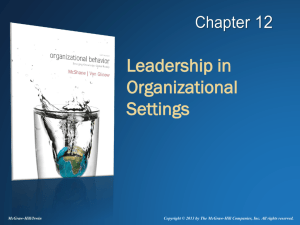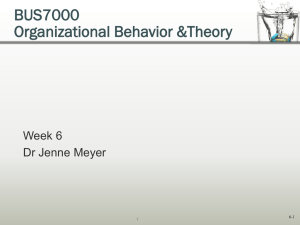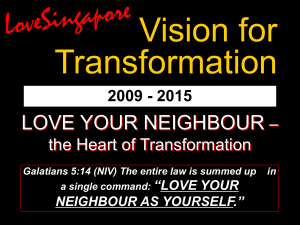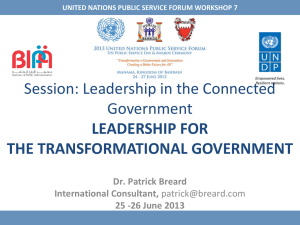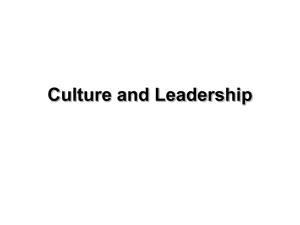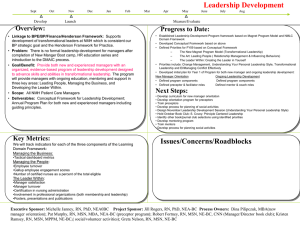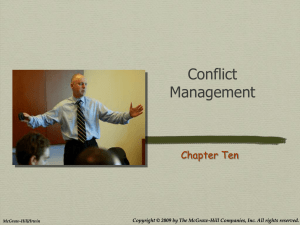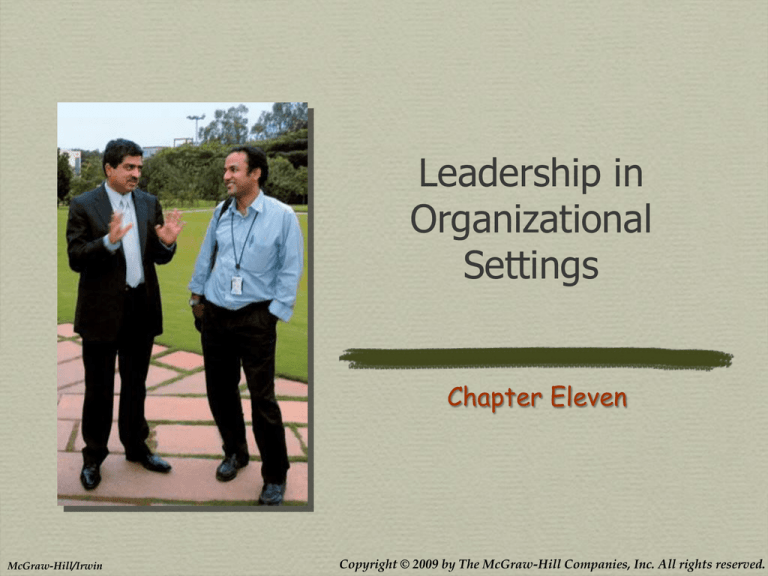
Leadership in
Organizational
Settings
Chapter Eleven
McGraw-Hill/Irwin
Copyright © 2009 by The McGraw-Hill Companies, Inc. All rights reserved.
Leadership at Infosys
“In essence, leadership
is about dreaming the
impossible and helping
followers achieve the
same.”
Nandan Nilekani (left in photo),
CEO of Infosys, one of India’s
largest and most successful
information technology companies.
11-2
Leadership Defined
Leadership is the ability
to influence, motivate,
and enable others to
contribute toward the
effectiveness of the
organizations of which
they are members
11-3
Shared Leadership
Leadership is not restricted to people in
formal management positions.
Anyone in the organization may -- and
should -- be a leader in various ways and at
various times.
Effective companies encourage employees
to be leaders when needed (e.g. change
champions)
11-4
Perspectives of Leadership
Competency
Perspective
Implicit
Leadership
Perspective
Leadership
Perspectives
Transformational
Perspective
Behavior
Perspective
Contingency
Perspective
11-5
Leadership
Competencies
Perspective
Leadership in
Organizational Settings
McGraw-Hill/Irwin
Copyright © 2009 by The McGraw-Hill Companies, Inc. All rights reserved.
Seven Leadership Competencies
Emotional
Intelligence
Integrity
Drive
Leadership
Motivation
• Perceiving, assimilating, understanding,
and regulating emotions
• Truthfulness
• Translates words into deeds
• Inner motivation to pursue goals
• Need for achievement, quest to learn
• High need for socialized power to
accomplish team’s or firm’s goals
more
11-7
Seven Leadership Competencies (con’t)
Self-Confidence
• Strong belief in one’s ability to lead
others
Intelligence
• Above average cognitive ability
• Can analyze problems/opportunities
Knowledge of
the Business
• Familiar with business environment
• Aids intuitive decision making
11-8
Competency Perspective Limitations
Implies a universal approach
Alternative combinations of competencies
might work just as well
Assumes leadership is within the person
But leadership is also about relations with followers
11-9
Leadership Behavior
and Contingency
Perspectives
Leadership in
Organizational Settings
McGraw-Hill/Irwin
Copyright © 2009 by The McGraw-Hill Companies, Inc. All rights reserved.
Leader Behavior Perspective
What makes Bruce Draper (shown here) one of the best bosses in Great
Britain? He provides plenty of supportive leadership, says employee
Hannah Delany. “Bruce cares about his staff and never takes them for
granted…He appears friendly, approachable and kind and makes sure
everyone is content in their job.”
11-11
Leader Behavior Perspective
People-oriented behaviors
Showing mutual trust and respect
Concern for employee needs
Looks out for employee well-being
Task-oriented behaviors
Assign specific tasks
Ensure employees follow rules
Set “stretch goals” to achieve performance capacity
11-12
Leader Behavior Perspective Limitations
People-task categories mask
subcategories of leader behavior
that may be distinct
Assumes best leaders display a
high level of both people and task
styles
But best style seems to depend on the
situation
11-13
Path-Goal Leadership Styles
Directive
Task-oriented behaviors
Supportive
People-oriented behaviors
Participative
Encouraging employee involvement
Achievement-oriented
Using goal setting and positive self-fulfilling
prophecy
11-14
Path-Goal Leadership Model
Employee
Contingencies
Leader
Behaviors
Leader
Effectiveness
• Directive
• Employee
motivation
• Supportive
• Employee
satisfaction
• Participative
• Achievementoriented
• Acceptance of
leader
Environmental
Contingencies
11-15
Path-Goal Contingencies
Employee
Contingencies
Directive Supportive Participative Achievement
Skill/Experience
low
low
high
high
Locus of Control
external
external
internal
internal
Environmental
Contingencies
Directive Supportive Participative Achievement
Task Structure
nonroutine
routine
nonroutine
?
Team Dynamics
–ve norms
low cohesion
+ve norms
?
11-16
Leadership Substitutes
Contingencies that limit a leader’s influence or make a particular
leadership style unnecessary.
Examples:
Training and experience replace task-oriented leadership
Cohesive team replaces supportive leadership
Self-leadership replaces achievement-oriented leadership
Research evidence: substitutes help, but don’t completely
substitute for real leadership
11-17
Transformational
Leadership
Perspective
Leadership in
Organizational Settings
McGraw-Hill/Irwin
Copyright © 2009 by The McGraw-Hill Companies, Inc. All rights reserved.
Transformational Leadership at P&G
Procter & Gamble CEO A. G.
Lafley practices transformational
leadership without using
charisma. By forming and
communicating a clear vision and
modeling that vision, he has
transformed the consumer goods
company.
11-19
Transformational v. Transactional Leaders
Transformational leaders
Leading -- changing the
organization to fit
environment
Change agents
Transactional leaders
Managing -- linking job
performance to rewards
Ensure employees have
necessary resources
Apply contingency leadership
11-20
Transformational v. Charismatic Leaders
Is charismatic leadership
essential for transformational
leadership?
Some experts say yes, but
emerging view is that:
Charisma is distinct from
transformational leadership
A personal trait that might help
transform, or might just help the
leader
Charismatic leadership might have
opposite effect -- creates
dependence, not empowerment
11-21
Transformational Leadership Elements
1. Create a strategic vision
Vision
—
—
Depiction of company’s (or work units) attractive future
motivates and bonds employees
May originate from others, but leader becomes a
champion of the vision
2. Communicate the vision
Frame message around a grand purpose
Create a shared mental model of the future
Use symbols, metaphors, symbols
11-22
Transformational Leadership Elements
3.
Model the vision
4.
(con’t)
Walk the talk
Symbolize and demonstrate the vision through their own
behavior
Builds employee trust in the leader
Build commitment to the vision
Increased through communicating and modeling the
vision
Increased through employee involvement in shaping the
shared vision
11-23
Evaluating Transformational Leadership
Transformational leadership is important
Higher employee satisfaction, performance, org
citizenship, creativity
Transformational leadership limitations
Circular logic -- leaders effective by definition
Universal theory
—
—
Need a contingency-oriented theory
Recognize differences across cultures
11-24
Implicit Leadership
Perspective
Leadership in
Organizational Settings
McGraw-Hill/Irwin
Copyright © 2009 by The McGraw-Hill Companies, Inc. All rights reserved.
Implicit Leadership Perspective
Followers’ perceptions about the characteristics
and influence of people they call leaders
Leadership prototypes
Preconceived beliefs about leader features/behaviors
Leaders evaluated against prototypes
Romance of leadership effect
Attribute outcomes to leaders because
—
—
Simplifies explanations
Illusion of control-- people control their environment
Fundamental attribution error
—
Leader given credit or blame for organizational outcomes
11-26
Cultural Issues in Leadership
Societal cultural values and practices affect leaders:
Shape leader’s values/norms
Influence decisions and actions
Some leadership styles are universal, others differ
across cultures
“Charismatic visionary” seems to be universal
Participative leadership works better in some cultures
than others
11-27
Gender Issues in Leadership
Male and female leaders have
similar task- and people-oriented
leadership.
Participative leadership style is used
more often by female leaders.
11-28
Evaluating Female Leaders
Past evidence
Women rated less favorably than equivalent male
leaders due to stereotyping
Recent evidence
Women rated more favorably than men,
particularly on emerging leadership styles
(coaching, teamwork)
11-29
Leadership in
Organizational
Settings
Chapter Eleven
McGraw-Hill/Irwin
Copyright © 2009 by The McGraw-Hill Companies, Inc. All rights reserved.

